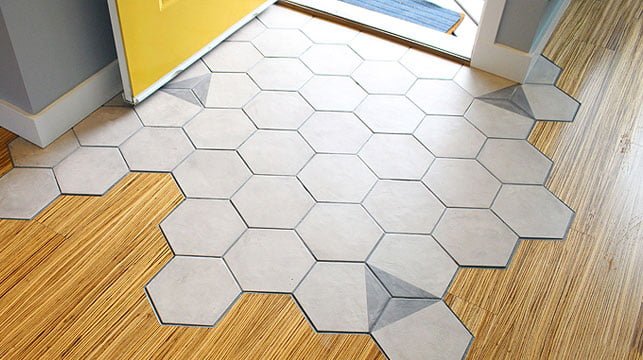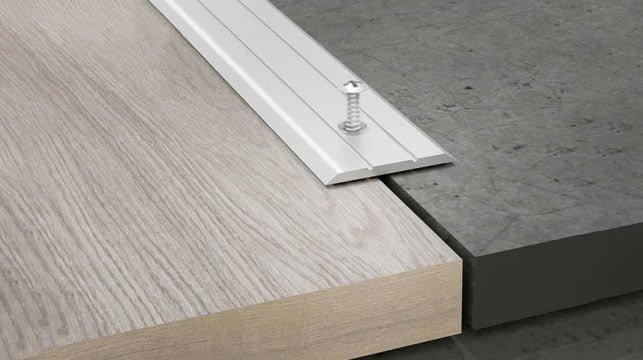People often think that mixing different flooring materials like tile and wood is a design no-no. But what if I told you it’s a popular trend that can add tons of character to your home?
Let me explain…
You know that feeling when you walk into a beautifully designed space and just can’t help but say “wow”? That awe-inspiring moment is often created by mixing different textures, colors, and materials. Using tile and wood together is one surefire way to achieve that wow factor.
So can you mix tile and hardwood floors? Absolutely! When done right, transitioning between tile and wood can create visual interest, define different spaces, and allow you to use the ideal flooring for each room’s purpose. The key is understanding how to blend the materials seamlessly.
In this article, we’ll dive deep into the world of kitchen tile to wood floor transition ideas. You’ll learn creative transition ideas, which tiles look best with wood, and pro tips for nailing this trendy look in your home. Get ready to be inspired!
Preparing for a Tile-to-Wood Floor Transition
Before we get to the fun design stuff, there’s an important first step – preparing the subfloor. Think of the subfloor as the foundation for your flooring project. If it’s not level, clean, and structurally sound, you could run into major problems down the road.
Here are a few subfloor prep musts:
- Level any significant humps or dips to create a flat surface
- Thoroughly clean up dust, debris, and old adhesives
- Check for any soft spots that could indicate moisture issues or structural damage
- Consider having a professional inspect the subfloor if you have any doubts
If the subfloor needs repairs, it’s best to take care of those first before laying your new tile or wood floors. A little prep work goes a long way in ensuring your hard work and investment lasts for years.
Choosing Complementary Tile and Wood Floors
This is where the fun begins! Deciding which tile and wood floor to use is the first step in creating that wow-worthy look. The options are endless, from sleek modern tiles to rustic reclaimed wood planks.
When selecting your tile and wood, keep these tips in mind:
- Look at the overall style and color palette in your home
- Choose floors that fit that vibe, whether it’s farmhouse, contemporary, traditional, etc.
- Consider factors like durability needs based on the room’s purpose
- Pick tiles and wood with finishes that play nicely together (matte, glossy, textured, etc.)
For example, a crisp white subway tile would create a beautiful contrast with rich walnut hardwood floors in a modern farmhouse kitchen. Or statement encaustic cement tiles could be the perfect pop against warm oak floors in a boho living room.
Don’t be afraid to look at inspiration photos and even order samples to get a real feel for how different tiles and woods work together.
4 Fresh Ideas for Transitioning Tile to Wood Floors
Now for the fun part – how to transition between your chosen tile and wood floors! There are several approaches, from ultra-seamless to intentionally defined. Here are four fresh ideas:
1) Use a Transition Strip

One of the most common (and easiest) methods is installing a transition strip between the tile and wood floors. These slim strips neatly cover the edge where the two floors meet.
Transition strips come in a variety of materials like wood, metal, and stone composites to coordinate with your floor finishes. Some even have a little decorative detail like a beveled edge or curved profile.
The best part about transition strips is they require zero customization. Just measure, cut, and secure them into place using construction adhesive or screws.
2) Overlap the Tile and Wood

For a seamless, integrated look, consider overlapping the tile over the edge of the wood flooring. This creates a smooth, unbounded transition between the two materials.
The key is ensuring the tile and wood are very close to the same height. Any more than a 1/4 inch height difference and the overlap could look awkward or be a tripping hazard.
This method works beautifully in open-concept floor plans, allowing the wood floors to effortlessly flow into a tiled kitchen or bathroom. It’s a great option if you want to maintain a cohesive feel throughout the space.
3) Install a Threshold Strip

If you have a noticeable height difference between the tile and wood floors, a threshold strip is likely your best solution. Unlike trim pieces, thresholds are designed with a small incline to bridge the gap smoothly.
Thresholds can be simple and understated or make more of a statement with carved wood detailing decorative tile inlays, or a contrasting material like stone. Many are customizable, allowing you to coordinate with your exact floor finishes.
This option works well when transitioning between floors on different levels, such as stepping down into a sunken living room with wood floors from the tiled entry.
Define the Space with Floor Design
Who says you have to blend the tile and wood seamlessly? For an intentional look, use each floor material to define and distinguish different spaces.
Some ideas include:
- Using wood floors in living areas and tile in work zones like kitchens and bathrooms
- Creating a borderless area rug effect by tiling a defined space within wood floors
- Carrying the wood floors from room to room, using tile only in transition areas like hallways
- Using contrasting shapes, like rectangular wood next to square tile
Get creative with floor patterns, directions, sizes, and proportions. A talented designer can make the two materials feel like the flooring equivalent of peanut butter and jelly!
Choosing the Right Kitchen Flooring Material
Since the kitchen is arguably the home’s hardest working room, flooring choice is crucial. You want a surface that can stand up to spills, stains, dropped dishes, and lots of foot traffic, while still being comfortable underfoot.
Here’s a quick rundown of some top kitchen flooring options and their pros and cons:
Tile
- Extremely durable and long-lasting
- Water, stain, and slip-resistant
- Available in virtually unlimited styles from rustic ceramic to sleek porcelain
- Can be cold and hard underfoot
- Grout lines require regular cleaning
Wood
- Adds natural warmth and beauty
- More comfy and forgiving underfoot
- Can be scratched or dented by dropped items
- Susceptible to moisture damage from spills
Luxury Vinyl Plank (LVP)
- Water-resistant and easy to clean
- Provides the look of real wood at a lower price
- Very durable and stands up to scratches
- Not considered a high-end product
As you can see, wood and tile both have their advantages in the kitchen. An easy solution is using wood in low-traffic areas and tile in the main work zones like surrounding cabinets and appliances.
Stylish Ways to Mix Tile and Wood Throughout the Home
Who says you have to pick just one type of flooring? Mixing tile and wood can work beautifully throughout an open floor plan when done intentionally. Here are some stylish examples:
1. Living Room to Kitchen
Define the living area with warm hardwood floors, then transition to classic checkerboard tile when you step into the kitchen’s work zone.
2. Entry to Main Rooms
Make a statement in the entryway with patterned tile floors, flowing seamlessly into hardwood plank floors throughout the main living spaces.
3. Bathrooms to Bedrooms
Durable, waterproof tile is ideal for bathrooms, while cozy wall-to-wall carpeting creates a soft atmosphere in the bedrooms. Use wood floors in the hallways to unite the spaces.
4. Basement
Create distinct areas by using large-format wood-look tile in the main hangout space, then real hardwood floors in a separate home gym or dry bar area.
The options are endless! Just be sure to carefully plan flooring transitions to maintain a balanced, cohesive look throughout your home.
Tips for Mixing Tile and Wood Like a Pro
Ready to dive into your mixed flooring project? Keep these pro tips in mind:
- Don’t let patterns clash or line up awkwardly at transitions.
- Use contrasting textures to add visual interest (matte tile with distressed wood, for example).
- Consider tone-on-tone shades for a more subtle, seamless blend.
- Be thoughtful about durability – use softer wood in low-traffic areas and durable tile in high-traffic zones.
- Create cohesion by using accent tiles or wood elements repeated throughout the space.
- Have floors installed by a professional to ensure a flawless, level transition.
Conclusion
Mixing tile and wood floors is an interior design trend that’s here to stay. When done right, blending these two materials adds seamless flow, visual interest, and gorgeous texture to your home.
The key is understanding how to choose complementary tiles and wood tones, as well as how to execute the actual transition between floors. With a variety of methods like transition strips, overlapping floors, threshold ramps, and intentional floor designs, there’s a solution for every style preference.
Don’t be afraid to get creative and mix tiles and hardwood throughout your home’s open spaces. Use the durable materials where they make sense – wood in cozy living rooms, and tile in hard-working kitchens – while allowing them to harmoniously blend in connecting areas.
When installing new floors, proper subfloor preparation is critical. But after that, have fun exploring different shapes, patterns, textures, and colors. The design possibilities are truly endless when you embrace the mixed tile and wood flooring trend.
If you’re still feeling unsure, hire an interior designer or flooring professional to guide you through tile and hardwood pairings, layout, and transitions. With some expert advice, you’ll be enjoying an elevated, magazine-worthy look on your beautifully cohesive yet diverse floors.
So go ahead and mix it up! Blending tile and wood is a fresh, modern approach that allows you to let your creativity shine. Your home will be inspiring major flooring envy in no time.


